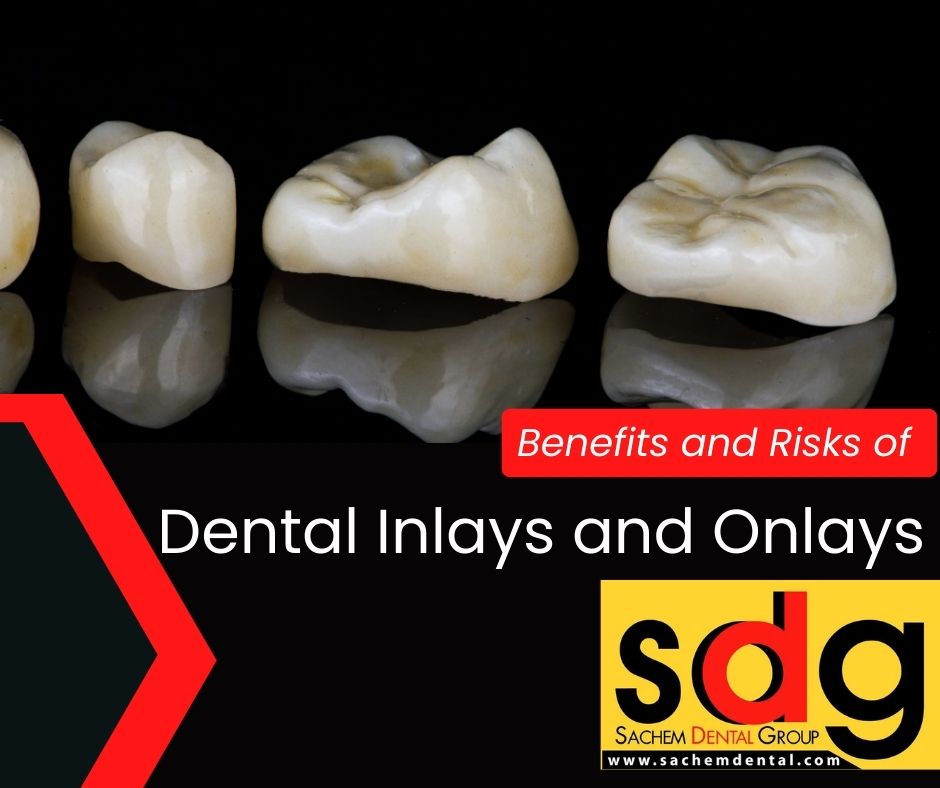
Our Long Island dentist often recommends inlays and onlays to repair teeth. As with all dental treatments, there are several benefits, but also a few potential risks involved with the procedure.
Inlay and Onlays vs. Fillings and Crowns
A filling is when you have a cavity that is cleaned out and the void in your tooth is filled back in with a tooth-colored composite resin material or metal amalgam material. Fillings are strong and can last for many years but they will eventually start to break down and need to be replaced. Also, the silver fillings can stain your teeth dark, and the material that the tooth-colored fillings are made from can stain over time.
A crown is another type of restoration which is a lab fabricated “cap” that fits over your tooth in order to protect it. Crowns are recommended when teeth are weak because of things like old large fillings, cracks, deep decay, or when they are partly broken. Crowns can last for about well over a decade or more when cared for properly. The material that crowns are made from is very strong ー either metal or a tooth-colored porcelain. Crowns are cemented onto your tooth where there will stay permanently.
Inlays and onlays are restorations that are used when something more than a filling is needed, but when a crown would be considered excessive. Both of these restorations are commonly referred to as partial crowns or three-quarter crowns. They are made from the same material as crowns and placed in a similar manner.
What Is The Difference Between an Inlay and Onlay?
An inlay is recommended when the part of a tooth that’s within the border of the cusps (biting edges) needs to be restored. The inlay sits “inside” your tooth.
An onlay is often recommend when your tooth has a broken cusp. The onlay sits “on” or over the tooth.
What Takes Place During an Inlay or Onlay Procedure?
The process for getting an inlay and onlay is quite similar to that of a crown. There will be two visits. The first appointment will be where we do the majority of the prepping, so you can expect the process to last about an hour and a half. During the second visit, we’ll place your permanent restoration, which usually doesn’t require any anesthesia and takes about 30 minutes or less.
To prep the tooth, we will first remove the decay or damaged enamel, then shape the tooth as appropriate for your restoration. Next, we take an impression of the tooth. This model will go to a dental laboratory where they will make your permanent restoration. It typically takes at least a couple of weeks for the product to come in from the lab, so you’ll wear a temporary onlay or inlay in the meantime. We will make the temporary for you at this initial visit.
While wearing your temporary restoration, you’ll need to be especially careful. Since it’s just made from a temporary material, it can break if you chew hard foods. The cement that we use to hold it in place isn’t as strong either, so you’ll also want to avoid eating sticky foods which can pull it off of your tooth.
When the time comes to place your final restoration, we’ll remove your temporary and attach your permanent one on with a strong cement.
Benefits of Inlays and Onlays
The following are some benefits of three-quarter crowns:
- Both of these restorations are made from the same strong material as crowns, which is either metal or tooth-colored porcelain. And in actuality, a gold onlay or inlay doesn’t look much different than metal amalgam fillings which may have already had in the past.
- Partial crowns don’t require as much alteration to the tooth as you would need for a full crown, meaning you can keep more natural tooth structure with this conservative restorative approach.
- Onlays and inlays are stronger than fillings.
- These restorations are easier to clean around than crowns because they don’t extend all the way to the gumlines.
- In most cases, inlays and onlays last longer than fillings do. In fact, you may get the same amount of time out of an inlay or onlay as you would a full crown.
Risks of Inlay and Onlays
Since neither of these restorations cover your tooth completely like crowns do, your natural tooth can still break down. If this happens, then you might end up with a full coverage crown after all. Or if too much of the tooth breaks, it may not even be possible to save it, resulting in the need for an extraction.
Cavities can develop around inlays and onlays that don’t fit right or aren’t cleaned correctly. Although they cover a large portion of your tooth, you still need to brush and floss each day to prevent bacteria from accumulating on the actual tooth surrounding it.
And just like other restorations, there’s always a small chance that your inlay or onlay can come loose. Sometimes the bonding agent won’t hold—like if you’re eating particularly sticky food—and the restoration will come off. If this happens, you can bring it with you and our Long Island dentist will cement it back in place. You’ll want to do this as early as possible, to avoid potential risk to your underlying tooth.
Restorative Dental Treatments in Suffolk County
If you have a cavity or a broken tooth, then call Sachem Dental of Long Island to schedule a consultation. We will take an X-ray of your tooth and examine it to determine if it can be restored, and what the best treatment options are for you.
When you’re a patient of our Suffolk County dental practice, you can rest assured knowing that you’re getting the best treatment available. We’ve been servicing this area for over 30 years so we are trusted by the community and look forward to having you join our dental family!
